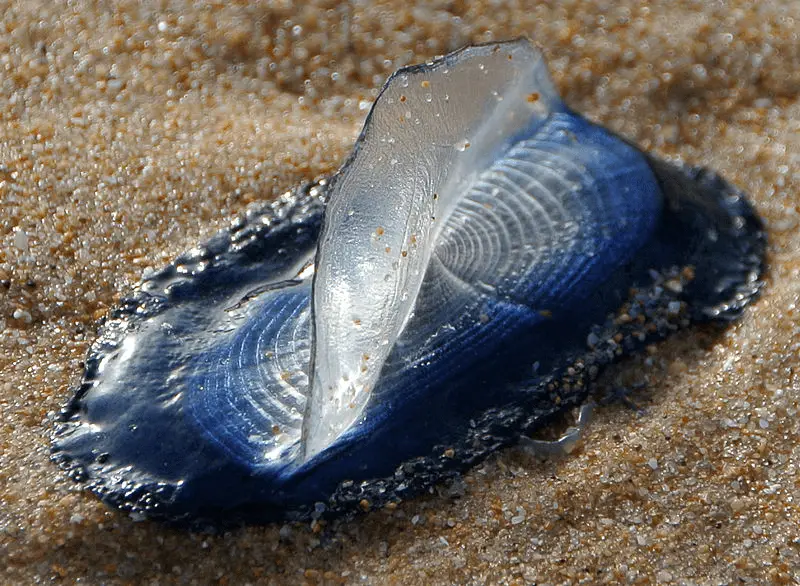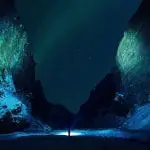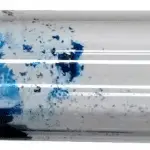Have you ever seen a creature so beautiful that it almost seems like straight out of fantasy? Have you heard the names sea raft, by-the-wind sailor, purple sail or little sail that all point towards the same organism?
Imagine yourself taking a walk along the beaches off California coast. You witness an unusual yet incredible sight of blue, transparent and inflated animals that seem to have invaded the coastline in millions. Intrigued by this description? These mystic creatures that give an ultimate science fiction feel are real animals called Vellela Vellela! And here’s a guide on everything you need know about them:
What is a Velella?
Velella is an ocean organism belonging to class hydrozoa. Hydrozoans are small and predatory organisms that live in either solitary or colonies in open sea water. Velella Velella (V.Velella) is the only known species of genus Velella. The scientists cherished the term V term to the extent that they kept it twice!
The easiest way to remember what these mysterious creatures are: things that are blue but not a jellyfish. Despite its common features and free floating nature, this sea raft belongs to its own group of hydrozoans called Velella Velella. The common link between the two organisms is that they belong to the same cnidarian family, causing confusion for masses. Interestingly, corals also belong to the same cnidaria phylum. Another free floating sea creature is Portuguese man-of-war that is quite similar to the mystic blue sailors.
Why is it called by-the-wind sailor?
Velella natural habitat is the open oceans far from the shore. They can be found in large numbers floating at the sea surface. However, the sea winds change their direction of movement and cause them to drift along the surface. It is interesting to note that ‘Velella’ is actually derived from the Latin ‘vēlum’ which means ‘a sail’ or ‘a cloth, covering, curtain or veil’. Moreover, in Latin the suffix ‘-ella‘ is commonly used to denote smallness or petite. The most logical explanation behind the term “Velella’ is that it means a ‘small sail.’
Having no means of locomotion other than its sail, V. velella is at the mercy of prevailing winds for moving around the seas, and are also subject to mass-stranding on beaches throughout the world. They have been reported at West Coast of North America, from British Columbia to California and west coast of Ireland and UK as well. Due to their negligible resistance power to winds, many colonies have been susceptible to frequent storms in East Pacific. Large swells of electric-blue sails are a common sight on the beaches located along the landfall of winds and storms.
Is Mass Stranding Common?
In the spring and summers, mass stranding is frequent on coasts along warm waters. It is an estimate that around a billion velella have been found dried up across the coastline of West Pacific. In 2005, several million blue sails drifted across coast of New Zealand prompting researchers to explore their life deeply. The mass stranding that caught international attention was in 2013-14 in the Mediterranean. People recorded the by-the-wind sailors spread along several kilometers of coastline in parts of Italy, United Kingdom and other areas. It gave an opportunity to the scientists to study the organism in greater detail and led to many new discoveries. Often, the stranding is to the extent that scientists call it a ‘Blue Tide’.
Where are they found?
They are distributed around the world in open oceans along temperate and tropical areas. Like most cnidaria, velella exist in a colony where may polyps live together. In their natural habitat, the polyps are connected with a canal system that lets them share food ingested by individual polyps. Many a times ships and offshore boats have across the free floating blue sailors in the open oceans miles away from the shore. Velellas are actually organisms that live partly in and partly out of the water and are known as pleuston. Pleuston derives from the Greek word for sailing, ‘pleusis which gives us a hint about their nature of existence. ‘Other examples of pleuston include the flying fish, diving bell spider and water striders among others.
How do they survive?
Velella is carnivorous and prey on zooplankton, fish eggs and larvae. They exist in a symbiotic relationship with the zooxanthellae that is a microscopic algae. On one hand the purple sail provides protection and food to the algae, on the other hand the algae provides photosynthetic energy and some additional nutrients. These microorganisms are found inside the tissues of velella. After the Mediterranean stranding, researchers found krill to be the highest consumed food by the little sailors.
The stinging tentacles of velella like other cnidarians produce a toxin called nematocysts to attract and then trap the prey. It is relatively harmless to humans, although each person may respond differently depending upon their allergic reactions. Their tentacles are small enough to not be able to penetrate thick human skin. It is advised to avoid touching your face or eyes after coming in contact with the sea creature. Predators like sea slugs belonging to the genus glaucus and purple snails feed on such cnidarians.
What’s the secret behind its magical blue color?
There are almost hundreds of things that are blue in nature, yet the Velella blue seems to be mystic. The scientific reason behind the color is the presence of a carotenoid pigment called astaxanthin. It is modified to be blue and serve to screen excess light in the bright ocean surface world. It is useful to protect the creatures from radiation they face due to constant floating at the surface.
Anatomy of a Velella
An individual velella has a flat upper body with a transparent structure above it. The size can vary from four to six inches. It is filled with air chambers that ultimately provide buoyancy to the organism. The protruding triangular and transparent jelly-like umbrella is made of chitin, a substance made from glucose. This part of the organism acts like a sail that drifts the velella in the direction of the wind. At an angle of45 degrees, the sail is either tilted in right or left direction. It is believed that this angle might help in showing resistance but in reality the by-the-wind sailors are easily swept away by the winds.
Below the body, there is an organ for specialized functioning i.e. either reproductive, a mouth for feeding or protective. Some polyps have both feeding and reproductive system and are known as gonozooids. Others that have only protective system are called dactylozooids. A Velella is incomplete without its stinging tentacles that come handy in catching a prey. The tentacles usually hang down in the water and help to stabilize the body allowing the sail to function. It is similar to how a yacht functions.
Lifecycle of a Velella
The by-the-wind sailors do not have a linear lifecycle but a bipartite one. In simpler terms, it means that an individual organism goes through both asexual and sexual reproduction in different stages of its life. The moon jellyfish-like things that are blue is the ‘polyp’ stage in the life of a velella. The deep blue sailors that are recognized by many beach-goers are in this phase of their cycle.
While free floating on the ocean surface, the polyps with reproductive system produce thousands of tiny umbrella-shaped microscopic creatures with tentacles. This is known as the “medusa” stage in their cycle, and they are reproduced through asexual budding process. The medusae (plural of medusa) feed on plankton and over several weeks come to an age of sexual maturity. Post this, they produce eggs and sperm that fuse and become larvae eventually making a whole new colony of Velella polyps.
Can Humans Consume Velella?
It is not common to cook up the blue sailors and eat them. However, the ill-effects of consuming them are not coherent so it is quite possible that some beach goer and a marine fan might have experimented with their diet! However, scientists recommend against consuming them.
Some people have also asked whether about the reaction of the blue tentacles on their dogs and cats. Scientists advise keeping your pets away from licking or eating velella. So the thumb rule is: Do Not Touch. Researches have also advised against taking them home from the beach since collecting marine life is not permissible at many places.
Imagine yourself free floating on the surface of the open ocean looking at the stars in the middle of the night. Now imagine you’re inverted. While you’re still free floating at the surface, you’re breathing through the water and staring right back at the infinite dark emptiness beyond you. This is what it feels like to be a Velella Velella! So the next time you come across these aesthetic creatures, take a pause and admire their beauty. Mother nature has many things that are blue just waiting to be discovered.
If you would like to know more about these incredible creatures, you can refer to the following:



